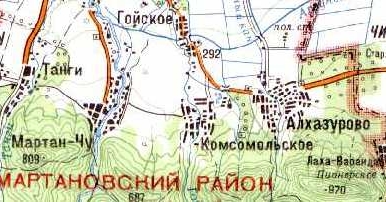The bloodiest battle of the second Chechen war By Ramzan Akhmadov
In early March 2000 a village in the south-west of the Chechen Republic saw some of the bloodiest combat in the whole of the two Chechen wars. Several detachments of Chechen guerrillas under the command of the well-known field commander Ruslan (Khamzat) Gelayev engaged with the Russian federal forces, which were far superior to their units, in more than two weeks of fighting.
The bloody massacre in Gelayev’s home village, Saadi-Kotar, was effectively the end of large-scale hostilities on the republic’s territory. And some observers believe that it was here for the first time that a mass surrender of Chechen guerrillas took place, after they were promised an amnesty by the federal command.
In spite of the fact that after almost continuous bombing coupled with rocket, artillery, flamethrower and tank fire, the village was then subjected to repeated "mop-ups", several people managed to survive under the ruins of the houses. Here is the story of one of them, whom we shall call Aslan:
"The soldiers completely blocked off the village, and they even kept civilians on the outskirts for several days, including us, as a kind of human shields. Yet most of the people who wanted to leave the surrounded village were women, children, and the elderly. There were constant artillery strikes and air raids, and the soldiers were using rockets and heavy Buratino flamethrowers. They also used the so-called ‘Gorynych Snake’, which fires a detonating cord that envelops everything around it. Not only the houses were on fire, but the ground was, too," Aslan continues. "It simply can’t be described in words."
"We were about a hundred metres from the cellar when there was suddenly a kind of hissing sound. Murad said to me: ‘Aslan, I think they (the Russians) have used gas!’ But then we realized we were wrong. It wasn’t gas, it was a flamethrower – a Buratino. Several metres away from us a young guy was crouching on all fours staring at us, his eyes wide with pain and horror. He burned to death in front of us. And there was nothing we could do. Everyone who was in that cellar was burned alive. There is only one word for what happened that day in Saadi-Kotar – it was a massacre. A real hell on earth."
"I’ve been told that a few other people also managed to survive. They managed to get out of the village after the Russian troops seized it. It’s said that one or two of the few dozen men who gave themselves up under the guarantee of the Russian generals remained alive. Some were brutally murdered, while the rest were ‘amnestied’, but some of them also disappeared in unexplained circumstances,” Aslan says.
The fighting in the village of Saadi-Kotar which began on March 5, 2000 did not end until the latter part of the month. The guerrillas who were killed in combat were later buried at cemeteries in neighbouring villages. Many of the bodies were unidentified, because they had been mutilated beyond recognition. Eyewitnesses have told of corpses with severed ears and noses, gouged-out eyes and severed limbs. But in the official reports of federal "victories” such details of the “war against terror” were never mentioned.
The full version of this story is available in Russian. (Translation by DM) (T) RELATED ARTICLES:
· Remembering Komsomolskoye (PW, 20.3. 2004)
DISCUSSION FORUM
|

